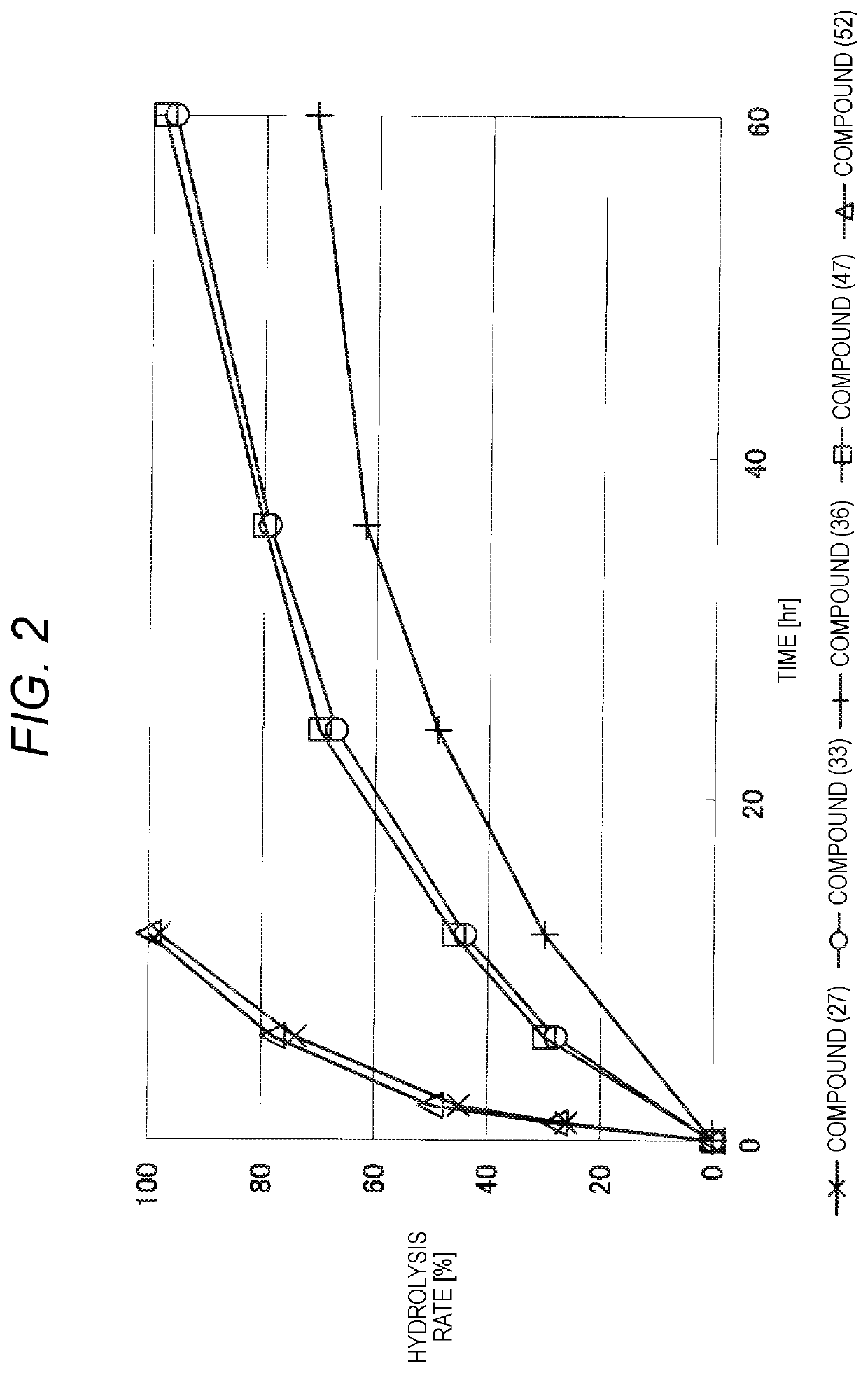Lipid derivative in which hydrophilic polymer is bound through cyclic benzylidene acetal linker
a cyclic benzylidene and hydrophilic polymer technology, applied in the field of lipid derivatives, can solve the problems of not being able to precisely control the hydrolysis rate, not being able to achieve precise control of the hydrolysis rate, and not being able to choose hydrazone. the best choice, etc., and achieve the effect of prolonging the circulation tim
- Summary
- Abstract
- Description
- Claims
- Application Information
AI Technical Summary
Benefits of technology
Problems solved by technology
Method used
Image
Examples
example 1
[0122]Into a 200 mL three-necked flask equipped with a thermometer, a nitrogen inlet tube, a stirrer, a Dean-stark tube and a condenser tube were charged 1,2,6-hexanetriol (30.0 g, 0.224 mol), acetone dimethyl acetal (25.6 g, 0.246 mol) and p-toluenesulfonic acid monohydrate (0.426 g, 2.24 mmol), and the reaction was performed at 80° C. for 3 hours while distilling off methanol. Triethylamine (0.453 g, 4.48 mmol) was added thereto and the mixture was stirred for a while, diluted with ethyl acetate, and washed with an aqueous 20% by weight sodium chloride solution. The organic layer was dried over anhydrous sodium sulfate, and after filtration, the solvent was distilled off under a reduced pressure. The residue was purified by silica gel chromatography to obtain a compound of formula (17).
[0123]1H-NMR (CDCl3, internal standard TMS); δ (ppm): 1.35 (3H, s, —CH3), 1.41 (3H, s, —CH3), 1.49-1.67 (6H, m, >CHCH2CH2CH2—), 2.07 (1H, brs, —OH), 3.51 (1H, t, —OCH2CHH2OH), 4.04 (1H, dd, —OCH2CH2...
example 2
[0125]Into a 500 mL four-necked flask equipped with a thermometer, a nitrogen inlet tube, a stirrer and a condenser tube were charged the compound of formula (17) (20.0 g, 0.115 mol), triethylamine (23.3 g, 0.230 mol) and toluene (200 g) and the mixture was cooled to 10° C. or less. While continuing the cooling, methanesulfonyl chloride (19.8 g, 0.173 mol) prepared in a dropping funnel was gradually added dropwise thereto. After the completion of the dropwise addition, the reaction was performed at 20° C. for 2 hours. Ethanol (7.97 g, 0.173 mol) was added and the mixture was stirred for a while and filtered. The organic layer was washed with ion-exchanged water, dried over anhydrous sodium sulfate, and after filtration, the solvent was distilled off under a reduced pressure to obtain a compound of formula (18).
[0126]1H-NMR (CDCl3, internal standard TMS); δ (ppm): 1.35 (3H, s, —CH3), 1.40 (3H, s, —CH3), 1.44-1.83 (6H, m, >CHCH2CH2CH2—), 3.01 (3H, s, —OSO2CH3), 3.51 (1H, t, —OCH2CHH2C...
example 3
[0128]Into a 500 mL four-necked flask equipped with a thermometer, a nitrogen inlet tube, a stirrer and a condenser tube were charged the compound of formula (18) (20.0 g, 79.3 mmol), potassium phthalimide (17.6 g, 95.2 mmol) and dehydrated dimethylformamide (200 g), and the reaction was performed at 60° C. for 2 hours. The mixture was cooled to 10° C. or less, ion-exchanged water (400 g) was added thereto and after stirring for a while, the mixture was extracted with a mixed solution of ethyl acetate / hexane (60 / 40 in v / v). The organic layer was washed with an aqueous 0.2% by weight potassium carbonate solution and dried over anhydrous sodium sulfate. After filtration, the solvent was distilled off under a reduced pressure to obtain a compound of formula (19).
[0129]1H-NMR (CDCl3, internal standard TMS); δ (ppm): 1.34 (3H, s, —CH3), 1.39 (3H, s, —CH3), 1.44-1.75 (6H, m, >CHCH2CH2CH2—), 3.50 (1H, t, —OCH2CHH2-phthalimide), 4.01-4.09 (2H, m, —OCH2CH2CHphthalimide)
[0130]
PUM
| Property | Measurement | Unit |
|---|---|---|
| pH | aaaaa | aaaaa |
| pH | aaaaa | aaaaa |
| weight | aaaaa | aaaaa |
Abstract
Description
Claims
Application Information
 Login to View More
Login to View More - R&D
- Intellectual Property
- Life Sciences
- Materials
- Tech Scout
- Unparalleled Data Quality
- Higher Quality Content
- 60% Fewer Hallucinations
Browse by: Latest US Patents, China's latest patents, Technical Efficacy Thesaurus, Application Domain, Technology Topic, Popular Technical Reports.
© 2025 PatSnap. All rights reserved.Legal|Privacy policy|Modern Slavery Act Transparency Statement|Sitemap|About US| Contact US: help@patsnap.com



